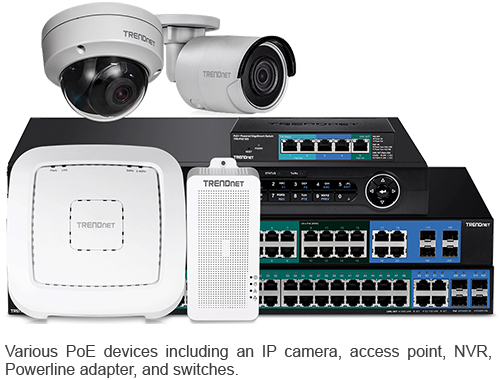How PoE Device Class Affects Your PoE Budget
July 2019
PoE (or Power over Ethernet) technology allows you to deliver both power and data over a single cable. This helps you to save on equipment and cabling costs. It also provides you with more installation flexibility since you won’t be restricted to setting up end devices next to power outlets. There are many devices that utilize PoE technology including powered devices (PD), such as IP cameras or access points, and power sourcing equipment (PSE), such as NVRs with built-in PoE switches, Powerline adapters, or standalone PoE injectors.>
There are different types of PoE: PoE, PoE+, and the relatively new UPoE and higher-power PoE standards. Each PoE standard allows for an increasing amount of maximum power that can be delivered to each device (or per each port of a connected PoE switch).
| Standard | Type | Max. Power per Port |
| 802.3af | PoE | 15.4W |
| 802.3at | PoE+ | 30W |
| 802.3bt | PoE++* / UPoE* | 60W |
| 802.3bt | 4PPoE* | 95W |
When planning your projects, remember to confirm total PoE budget. If you have two PoE ports, but only a 20-watt PoE budget, both ports will not be able to supply the full 15.4 watts of power to those ports simultaneously. Luckily, most PoE end devices do not require the full PoE budget the standard allows.

PoE Device Classes
PoE devices do not usually use the maximum amount of power that their respective PoE standards allow. For example, a port on a PoE switch supplies up to 15.4 watts of power, but your PoE camera may only need 9 watts of power. However, each PoE device is assigned a PoE class, and this may affect your total available PoE budget.
| Class | Standard | Type | Max. Power Available |
| 0 | 802.3af | PoE | 15.4W |
| 1 | 802.3af | PoE | 4.0W |
| 2 | 802.3af | PoE | 7.0W |
| 3 | 802.3af | PoE | 15.4W |
| 4 | 802.3at | PoE+ | 30W |
| 5 | 802.3bt | PoE++* / UPoE* | 45W |
| 6 | 802.3bt | PoE++* / UPoE* | 60W |
| 7 | 802.3bt | 4PPoE* | 75W |
| 8 | 802.3bt | 4PPoE* | 95W |
Your device’s PoE class will let your PoE switch know the maximum amount of power that PoE device may require. However, if your PoE device needs less than the maximum wattage to operate, the PoE switch may still reserve the amount of maximum wattage based on the PoE class.
For example, TRENDnet’s 8MP 4K H.265 PoE IR Bullet Network Camera (TV-IP318PI) is a PoE camera with a maximum power consumption of 7.5 watts. However, since the PoE camera is designated as a class 3 PoE device, the connected PoE switch may reserve the full 15.4 watts power maximum. This would reduce your PoE switch’s total available PoE power budget by 15.4 watts, instead of just 7.5 watts.
If you’re unsure what class your PoE end device is, a good rule of thumb is to round up (based on the maximum wattage available per class). Note that not all PoE switches will reserve power based on the PoE class; some PoE switches may determine available power based on current PoE load.

* The 802.3bt standard was recently ratified, and the industry-accepted designation may change.

